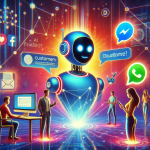ChatActor.com - AI Chatbot for customer service
How AI Chatbots Are Changing the Customer Support Game
Introduction
Imagine calling customer service, bracing yourself for long hold times, and listening to that looped, tinny music. Frustrating, right? Now picture this: instead of a long wait, your question is answered instantly—24/7, no matter how busy the company is. This isn’t just a vision of the future; it’s the reality businesses embracing AI chatbots are enjoying today.
In a world where customers demand quick, efficient, and personalized interactions, traditional customer service struggles to keep up. Enter AI chatbots—the tech-powered allies transforming customer support into a seamless, always-on experience.
But let’s not just focus on what chatbots do. Let’s talk about why they matter. Whether you’re running a small business looking to scale or managing a global brand juggling thousands of customer queries, AI chatbots are rewriting the rules of engagement. They’re not here to replace human interactions but to enhance them—taking over repetitive tasks and freeing up humans for more complex, meaningful connections.
This article dives into the fascinating rise of AI chatbots in customer support. We’ll explore how this technology evolved, why businesses are racing to integrate it, and what it means for customer satisfaction and business growth.
The Evolution of Customer Support
To appreciate how far we’ve come, let’s take a trip down memory lane.
Not so long ago, customer service revolved around two main options: phone calls and emails. Both were far from perfect. Phone lines got clogged, emails were often buried under piles of correspondence, and customers were left frustrated and impatient. It was like trying to cross a river with a rickety wooden bridge—functional, but far from smooth.
Then came the rise of live chat support, which added a layer of immediacy. Yet even that had its limitations. Human agents could only handle so many chats at a time. Staffing a 24/7 team was costly, and no matter how skilled, humans are prone to fatigue and errors.
This is where AI chatbots entered the scene, like skilled multitaskers who could walk the tightrope of customer service demands without missing a step. Unlike their human counterparts, chatbots don’t sleep, don’t lose patience, and don’t call in sick. They’re the steel suspension bridge to the future—strong, reliable, and always open.
Take the story of a mid-sized online retailer who struggled with scaling their customer service as their business grew. Customers often faced delays in responses, especially during peak shopping seasons. When they implemented an AI chatbot, it was like flipping a switch. The bot handled FAQs, processed returns, and even recommended products—all without a single delay. Their team’s workload lightened, customer satisfaction soared, and revenue increased by 25% in just six months.
The evolution of customer service isn’t just about efficiency—it’s about creating experiences. Chatbots are helping businesses transition from reactive service to proactive engagement, turning support into a strategic asset rather than a necessary expense.
Chat Actor – AI Chat Bot for your customer service. Sign Up Now
How AI Chatbots Work
Imagine stepping into a bustling café where the barista knows your name, your favorite drink, and even that you prefer an extra shot of espresso on rainy mornings. Now, picture that same level of personalization in your customer service experience—but instead of a barista, it’s an AI chatbot serving up solutions.
At its core, an AI chatbot is more than just a programmed responder. It’s a digital maestro, orchestrating data, algorithms, and human-like interactions to create seamless conversations. Let’s break down how these tech-savvy assistants work behind the scenes, bringing a touch of magic to customer support.
Natural Language Processing: The Chatbot’s Ears and Mouth
The first step in any conversation is understanding, and for AI chatbots, that’s where Natural Language Processing (NLP) comes into play. NLP acts like the ears and mouth of the chatbot, enabling it to “listen” to your queries, process what you mean, and respond in a way that feels almost human.
Think of NLP as the chatbot’s translator. Customers don’t speak in perfect scripts—they ramble, misspell, or type in shorthand. NLP deciphers these nuances, like a multilingual friend who can understand both text slang and formal speech.
For example, a customer might type, “Can u pls help w/ my order???” An AI chatbot, equipped with NLP, will interpret the query as: “I need assistance with my order.” It’s not just about recognizing words; it’s about grasping intent.
Machine Learning: The Brain that Learns and Adapts
Once a chatbot “understands” the question, its brain—powered by Machine Learning (ML)—kicks in. ML is like a student who’s always in class, constantly learning and improving based on past interactions.
When a chatbot starts, it might have a limited set of responses. But over time, as it processes more queries and learns from user feedback, it gets smarter. It begins to predict needs, refine answers, and even anticipate follow-up questions.
Here’s a relatable analogy: imagine teaching a child to tie their shoes. At first, they fumble and might ask questions at every step. But with practice, they not only master the task but can eventually teach someone else. Similarly, chatbots evolve from basic responders to insightful problem solvers.
Integration with Platforms: The Connector of Experiences
An AI chatbot isn’t just floating in cyberspace; it’s deeply integrated into platforms like websites, Facebook Messenger, and WhatsApp. This integration allows it to access real-time customer data, like purchase history or browsing behavior, creating a cohesive experience.
Picture a loyal customer visiting your online store. The chatbot, like a seasoned shop assistant, recognizes them, recalls their past purchases, and suggests complementary items. It’s not guessing—it’s connecting dots from integrated data.
A Day in the Life of an AI Chatbot
Let’s bring this to life with a story. Imagine a chatbot named “Bella” working for a small handmade jewelry business. One evening, a customer messages Bella on Facebook Messenger:
“Hey, I’m looking for a gift for my wife. Any recommendations?”
Bella doesn’t just send a generic response. Thanks to NLP, Bella understands the intent and uses ML to analyze the customer’s past purchases. She replies:
“Hi there! Based on your previous orders, your wife seems to love minimalist designs. How about these silver stud earrings? They’re part of our new collection!”
In seconds, the customer feels seen, understood, and valued—all because Bella, the AI chatbot, is doing its job flawlessly.
Key Benefits of AI Chatbots in Customer Support
Imagine you’re at a bustling café during the morning rush. The line stretches out the door, but instead of chaos, everything moves seamlessly. Orders are taken quickly, each cup customized perfectly, and no one leaves without a smile. That’s the level of efficiency and satisfaction AI chatbots bring to customer support—except they’re not just serving coffee; they’re solving problems, answering questions, and delighting customers around the clock.
Incorporating AI chatbots into customer service isn’t just about keeping up with trends; it’s about transforming the way businesses interact with their customers. Let’s explore the game-changing benefits these digital assistants bring to the table.
1. Always On: 24/7 Availability
Imagine if your business had a customer support agent who never slept, took no breaks, and was always ready to help. That’s exactly what an AI chatbot offers—uninterrupted availability that ensures no customer query goes unanswered, no matter the time zone or hour.
For example, consider a small e-commerce business selling handmade goods. Before adopting an AI chatbot, customers often had to wait until the next business day for replies, especially during weekends or holidays. Now, with the chatbot in place, customers can get answers about shipping times, product details, or return policies instantly, even at midnight.
Think of it as having a tireless concierge at the front desk of a hotel, ready to assist every guest, any time they walk through the door. The result? Happier customers and more opportunities to convert inquiries into sales.
2. Speed Meets Efficiency
When customers reach out for support, they’re often looking for one thing: a fast solution. AI chatbots excel here, cutting response times down to seconds. Unlike human agents, who can handle a limited number of interactions at once, chatbots can juggle multiple conversations simultaneously without breaking a sweat.
Let’s say a customer visits your website to ask about tracking their order. In the past, they might have had to submit a ticket and wait for an email response. But now, with a chatbot in place, the interaction goes something like this:
Customer: “Where’s my order?”
Chatbot: “Sure! Could you provide your order ID?”
Customer: “12345.”
Chatbot: “Thanks! Your package is en route and should arrive by Thursday.”
In less than a minute, the customer has their answer, leaving them impressed by the efficiency. It’s like having a Formula 1 pit crew handling each request—fast, precise, and effective.
3. Cost Savings and Scalability
Running a customer support team can be expensive, especially as your business grows. AI chatbots help reduce these costs without compromising service quality. By handling repetitive tasks and FAQs, they allow human agents to focus on more complex queries, optimizing both resources and budgets.
For instance, imagine a seasonal spike in demand during Black Friday sales. Instead of hiring temporary agents or overburdening your existing team, your chatbot can scale effortlessly to manage the increased volume. It’s like adding extra lanes to a highway during rush hour—traffic flows smoothly, and everyone gets where they need to go.
Future Trends in AI Chatbots
Imagine looking into a crystal ball and seeing a world where customer service feels less like a transaction and more like a personalized conversation with a trusted advisor. That’s the future AI chatbots are building—not just smarter interactions, but experiences that leave customers feeling understood, valued, and delighted.
As technology advances, the potential of AI chatbots continues to grow. Businesses already adopting this innovation are ahead of the curve, but what lies on the horizon promises to transform customer support in ways we’re just beginning to imagine. Let’s explore some of the most exciting trends shaping the future of AI chatbots.
1. Hyper-Personalization through Advanced AI
Think about how Netflix seems to know exactly what you want to watch next or how Spotify curates the perfect playlist for your mood. This level of personalization is making its way to AI chatbots. Future chatbots won’t just remember your name—they’ll understand your preferences, anticipate your needs, and offer tailored solutions that feel uniquely crafted for you.
For instance, imagine visiting an online clothing store where the chatbot greets you with:
“Welcome back! The new arrivals in your favorite brand, [Brand Name], are here. Shall I show you the collection in your size?”
By leveraging advanced data analytics and customer profiles, chatbots will act more like personal shoppers or lifestyle assistants. It’s not just about answering questions; it’s about creating a one-of-a-kind experience every time.
2. Conversational AI with Emotional Intelligence
In the future, chatbots will go beyond understanding words—they’ll recognize and respond to emotions. Using sentiment analysis and voice tone detection, these bots will be able to adjust their approach based on the customer’s emotional state.
Picture this: A frustrated customer messages a support chatbot about a delayed shipment. Instead of offering a generic reply, the bot detects the frustration and responds empathetically:
“I’m so sorry to hear about the delay. Let me make this right for you right away!”
This kind of emotional intelligence will bridge the gap between human and AI interactions, making chatbots more relatable and trustworthy.
3. Seamless Integration with Emerging Technologies
The future isn’t just about smarter chatbots; it’s about how they integrate with other cutting-edge technologies. Imagine a chatbot that can interact with your smart home devices or even augment customer experiences with virtual and augmented reality (VR/AR).
For example, a furniture retailer could use a chatbot to guide customers in designing their living spaces. The bot might say:
“Let’s visualize that sofa in your living room! Click here to activate AR, and you’ll see how it fits with your current décor.”
These integrations will make chatbots indispensable tools for enhancing customer experiences, not just in communication but across entire business ecosystems.
Chat Actor – AI Chat Bot for your customer service. Sign Up Now
Conclusion
Picture this: a customer logs onto your website at 2 a.m., desperate for help with a product issue. Instead of waiting until morning for assistance, they’re greeted instantly by an AI chatbot. Within minutes, their problem is resolved, their trust in your brand solidified. This isn’t a far-off dream—it’s the reality of customer support powered by AI chatbots.
AI chatbots are more than just tools; they’re partners in creating exceptional customer experiences. From their tireless availability to their ability to anticipate customer needs, they’ve redefined what businesses can achieve in customer service. They work like a digital bridge, connecting businesses to their audiences with efficiency, empathy, and innovation.
For businesses considering the leap, the message is clear: AI chatbots are no longer optional—they’re essential. Whether you want to improve response times, scale support without adding costs, or create personalized interactions that wow your customers, chatbots are the key to staying competitive in a fast-paced digital world.
By embracing this technology, you’re not just investing in a tool—you’re investing in the future of your business. The rise of AI chatbots isn’t just a trend; it’s a revolution that’s here to stay. And the best part? This revolution is open to everyone, whether you’re a small business or a global enterprise.
The time to act is now. Are you ready to transform your customer support game and build connections that last?







